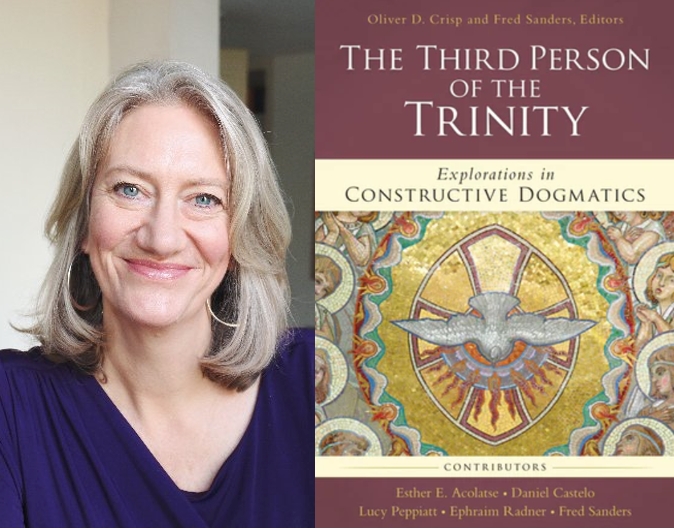
Dr. Lucy Peppiatt was one of the plenary speakers at the 2020 Los Angeles Theology Conference, and published her paper as a chapter in the resulting book, The Third Person of the Trinity (just out this month from Zondervan Academic). Her chapter is entitled “The Spirit of the Lord: Reflections on a Christomorphic Pneumatology.” I asked her a few questions about the project and how it relates to her other work. Here are her answers.
What’s your chapter in The Third Person of the Trinity about?
My chapter in the book is on a christomorphic pneumatology – what it means to say that the Holy Spirit is the Spirit of Jesus Christ. The NT refers to the Spirit as the Spirit of Jesus/Christ/the Lord/the Son and so I wanted to explore some of the implications of what that might mean and how we understand the person and work of the Spirit if the Spirit is shaped by Christ. I talk about trying to navigate the way we understand the Trinity as both one and three and the unity and distinction of the Son and the Spirit, so we can’t separate them in our thinking and understanding, but neither should we conflate them. I think it helps to understand the Son and the Spirit as having distinct operations in the world, but that the Son and the Spirit are always working together. So then I consider what it might mean to think about the distinct operations of the Spirit in the world as shaped by what we know of Christ. If he is the bearer and sender of the Spirit, then what might the Spirit’s work look like if it is christomorphic?
I could have taken this in lots of directions! I decided to focus on accounts of kenosis in relation to Christ, partly because it’s a popular lens through which to understand the person of Christ and the Christian life (and in some forms of contemporary expression, I think it has some real merits to it), but also because I think it is often given too much weight in Christology and needs to be counter-balanced with other perspectives. I think a focus on the filling of the Spirit of Christ is a good corrective to narratives that over-emphasize self-emptying and so I explore how plerosis changes what we understand about kenosis, especially in the light of the fact that we don’t separate Christ and the Spirit and that the Spirit is Christ-shaped. This guards against us claiming, if I can put it crudely, that this person of the Trinity only does this and that one only does that. It also sheds light on who God is and how he works in the world because we don’t see the Spirit as some kind of independent force in the world distinct from the Father and the Son. I conclude, then, that a focus on Christ and the Spirit opens up ways of perceiving God at work in and through both emptiness, desolation, and weakness as well as in and through filling his people with abundant life, joy, and peace.
How does this chapter fit into your teaching or your writing?
I teach courses in Christian doctrine and in spiritual formation at Westminster Theological Centre, so anything christological and pneumatological fits in with almost everything I teach! The majority of our students attend charismatic and Pentecostal churches and most of them are familiar with that world, so our discussions often revolve around the work of the Spirit in the church and in the world. I very much welcomed the opportunity to write something more on pneumatology for the conference, especially from a christological perspective, and at some point, I’d like to write more on how we understand what it means to be a Spirit-filled people.
Where did the idea for this particular essay come from?
My PhD was in Spirit Christology – how Christ is ‘of the Spirit.’ I loved working on those ideas, but I suppose I felt that it was time to think the other way round from a dogmatic perspective. I also wanted to do some further reflection on how we can express the idea that the Spirit inhabits the pain and emptiness of existence as well as giving us fullness of life. I think we’re in a muddle in charismatic circles about what the presence
and the power of the Spirit looks like in individual lives and communities, and we have little space for stories that don’t have ‘happy’ endings. I think we need a better theology for this so this was a beginning of me trying to think through those kinds of things.
What’s the next thing you’re working on, or looking forward to working on?
I’m currently working on a Cascade Companion on the Imago Dei and I’m loving doing that. I have some work lined up on both 1 Corinthians and the Pastoral Epistles, and as I said above, at some point in the future, I’d like to turn my attention to pneumatology and theological anthropology.
A bonus question not related to this book chapter: What’s the most stimulating thing you’ve read lately in theology?
Without doubt, this was Lisa M. Bowens book, African American Readings of Paul. But I’ve also just been re-reading sections of Against the Heresies for class prep in January, so I have to include that!
For more sneak-peeks of The Third Person of the Trinity, check out our other interviews. You can pick up a copy of the book here.